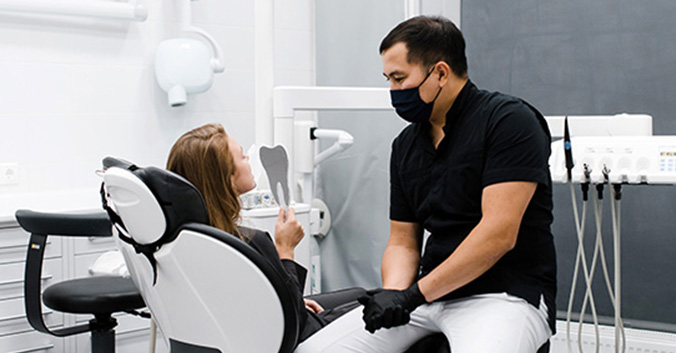
4 ways to help reduce patients’ fear of the dentist
Fear of visiting the dentist affects up to a nearly a quarter of people worldwide. It’s very likely that some of the patients you see every day are experiencing anxiety while they’re in your office. Here are four things you can do to help patients who are feeling afraid or stressed during visits.
Know the difference between anxiety and fear
When it comes to anxiety and fear, the difference is a matter of degree. Anxiety is an emotion characterized by feelings of tension, worried thoughts and physical changes like increased blood pressure, according to the American Psychological Association. But phobia is a persistent, excessive, unrealistic fear of an object, person, animal, activity or situation. A patient that feels nervous about the prospect of needing fillings but is able to undergo the procedure has anxiety. In contrast, a patient that is so afraid of needing fillings that they won’t even go to the dentist’s office has phobia.
There are many reasons why patients might experience anxiety at the thought of going to the dentist. If they haven’t been in a while, they may be afraid of learning about potential problems they may have developed, like cavities or gum disease, or worried that they will be judged for their lax behavior, like not brushing, flossing or visiting the dentist more regularly. They may be concerned about the potential costs if they require extensive treatment.
You can help address some of the causes of mild anxiety by providing a supportive environment, not scolding patients for sub-optimum at-home care or offering flexible payment options for high-cost procedures. Patients with dental phobias, however, may require more in order to feel comfortable.
Know the underlying causes and signs of fear
When treating a patient who has dental phobias, it’s important not to take their fear personally. The stress and fear that they feel isn’t being caused by you, but by an underlying issue. Dental phobias can have many causes, such as:
- Traumatic experiences with dental care or other forms of health care (making sure kids have a positive experience at the dentist is a great way to avoid fears later in life)
- Generalized anxiety, depression or post-traumatic stress disorders
- Fear of a loss of autonomy and control
- Trust issues or fear of betrayal
- Other fears, such as agoraphobia (fear of being in situations that might cause panic, helplessness or embarrassment) or claustrophobia (fear of enclosed spaces)
Patients who are experiencing high levels of fear or anxiety may exhibit the following signs:
- Sweating
- Visible distress, tension, crying or signs of panic
- Inappropriate emotional responses, such as withdrawal, excessive humor or aggression
By being able to identify the signs of fear, you can help patients who may not openly express any emotional or physical discomfort they’re feeling.
Emphasize communication and put the patients’ needs first
Communication is essential when it comes to working with patients to help them overcome their dental anxiety. You can ask open-ended questions like “How are you doing?” to determine the severity of the fear and anxiety they’re currently experiencing. There are even standardized questionnaires such as Corah’s Dental Anxiety Scale (PDF) and the Modified Dental Anxiety Scale (PDF) that you can share with patients at the beginning of their visits to help identify the specific issues they might be feeling anxious about.
Once you know what patients are specifically afraid of, work with them to alleviate their fears.
- For patients who would feel more secure knowing exactly what to expect during their visit, go slowly and explain what instruments you’ll be using and why.
- For patients who would rather distract themselves while receiving care, you can keep tablets at your practice for streaming videos or music. You can also encourage patients to bring their own such devices.
- For patients open to alternative methods of stress relief, try aromatherapy, weighted blankets, guided meditation or toys to keep their hands busy.
- Finally, let patients know that nitrous oxide gas, oral sedation and IV sedation are available to put them in a more relaxed mental state. Note that your patients’ plans may not cover this usage of sedatives and it could increase their out-of-pocket costs.
Sometimes the patient needs more help than you can give them
Despite your best efforts, some patients may simply experience greater fear and anxiety than you can help them cope with. Sedation may help them to deal with pressing dental needs, but professional therapy may be necessary for them to overcome their fears of visiting the dentist. Patients may even prefer to see a therapist, as a study of dental patients with severe anxiety and fear, found that those patients reported feeling more comfortable with behavioral therapy than sedation.
For patients who want professional help overcoming their fear of dentistry, it may be helpful to develop relationships with psychologists and therapists near your office that you can recommend to patients. If you don’t know any, you can also refer patients to professional organizations like the American Psychological Association.
Recent posts
- Updated 2026 CDT codes are here
- Partner with us to improve the health outcomes of our shared members
- Say hello to our 2026 Medicare Advantage DHMO partners
- Say hello to our 2026 Delta Dental Medicare Advantage™ PPO partners
- Insights from Dr. Allen Edwards on oral cancer detection and prevention
- Create a PPO strategy for your dental practice
- Dr. Brian Hathcoat — how a career change and a commitment to service made a positive impact
- Menopause and the mouth: What our survey results are saying
- Ready, set, authenticate with multi-factor authentication
- Partners in care: Reduce patient grievances with our on-demand webinar
